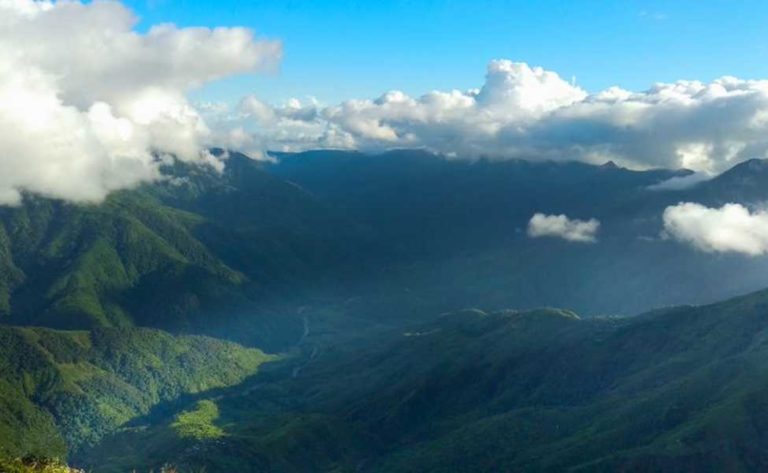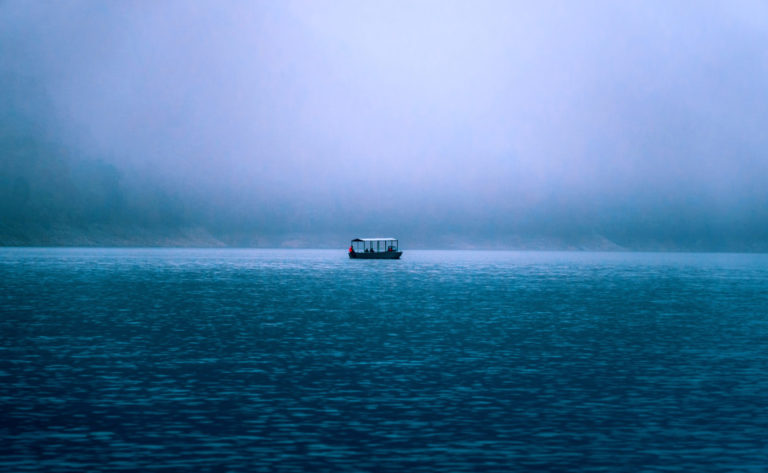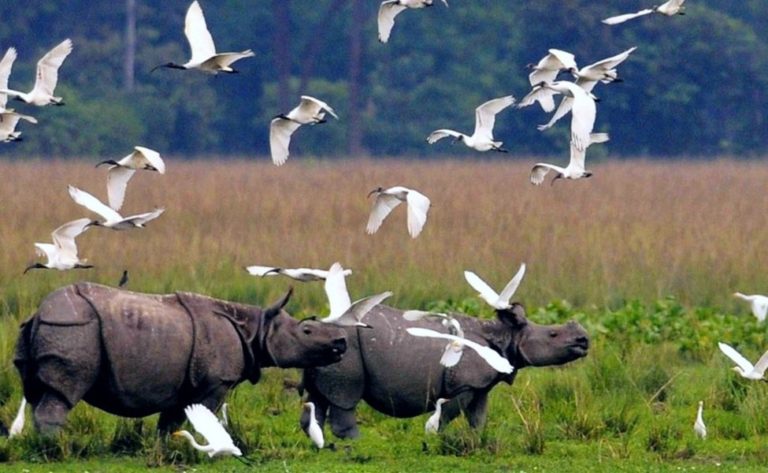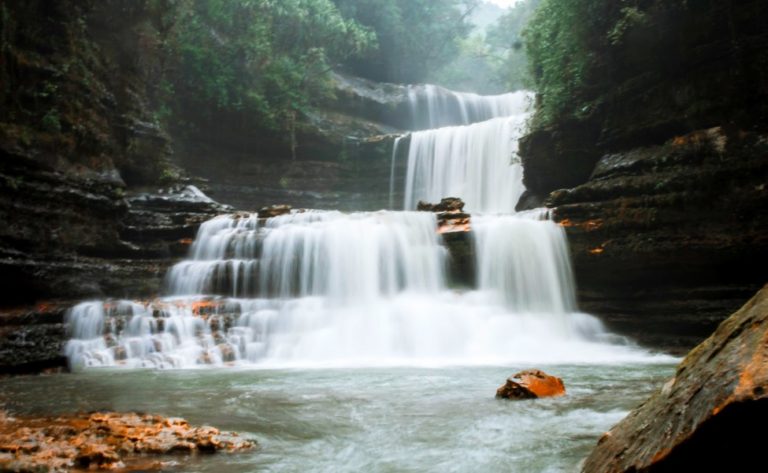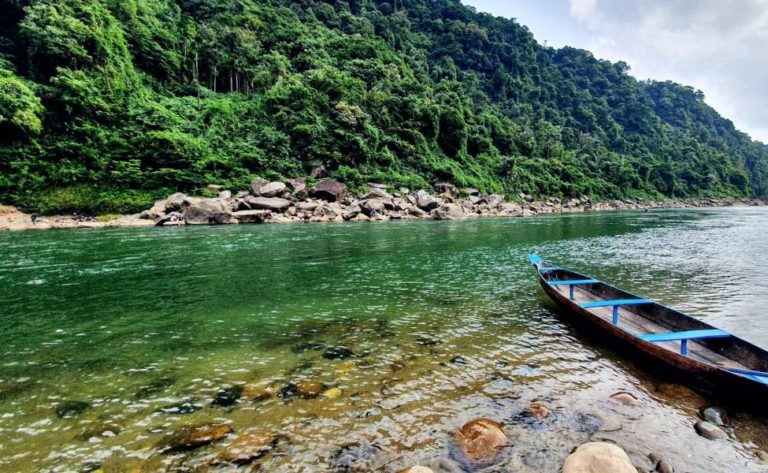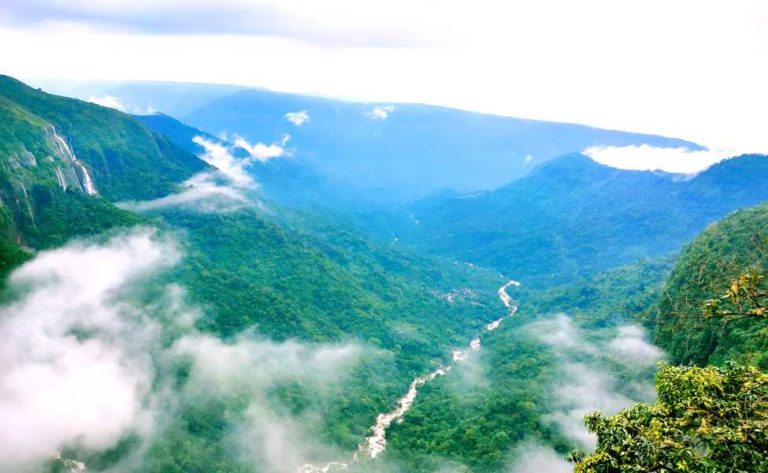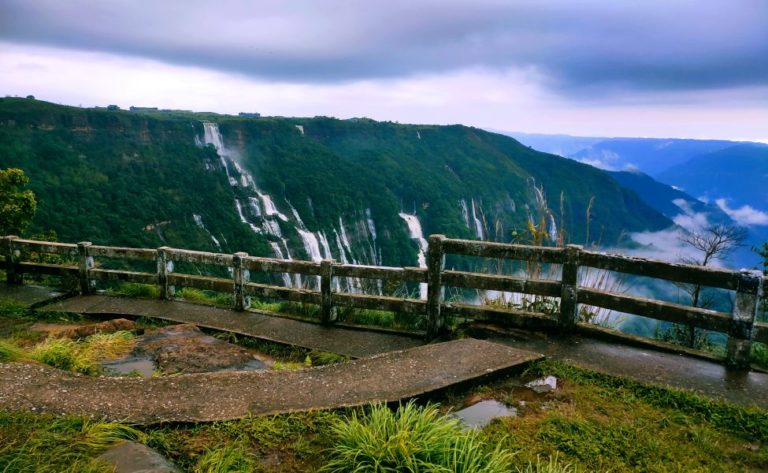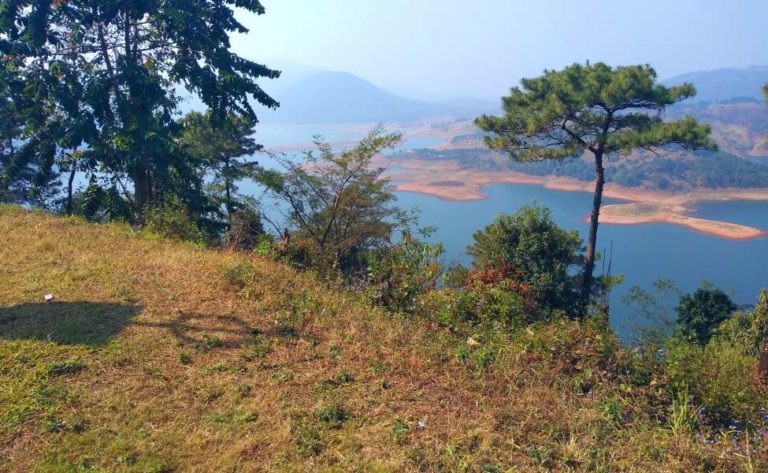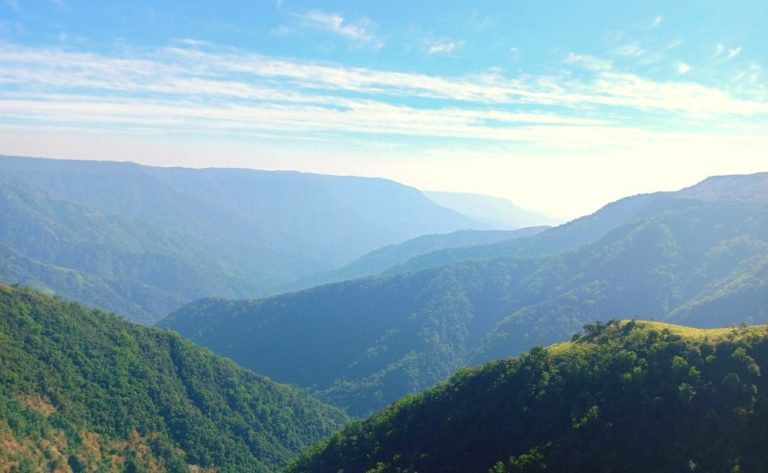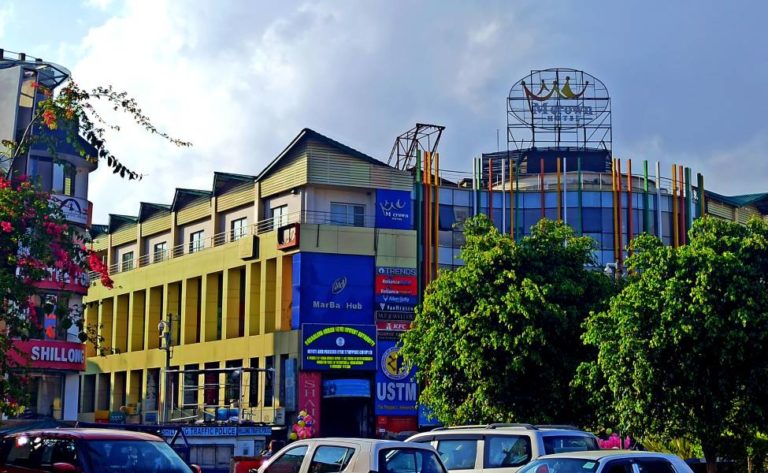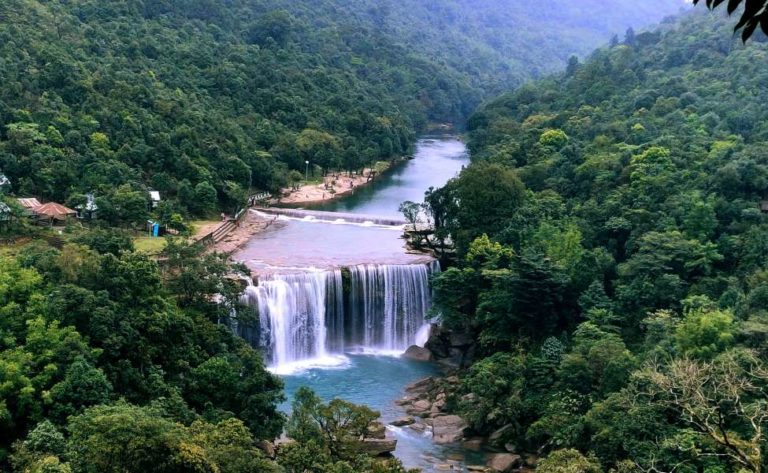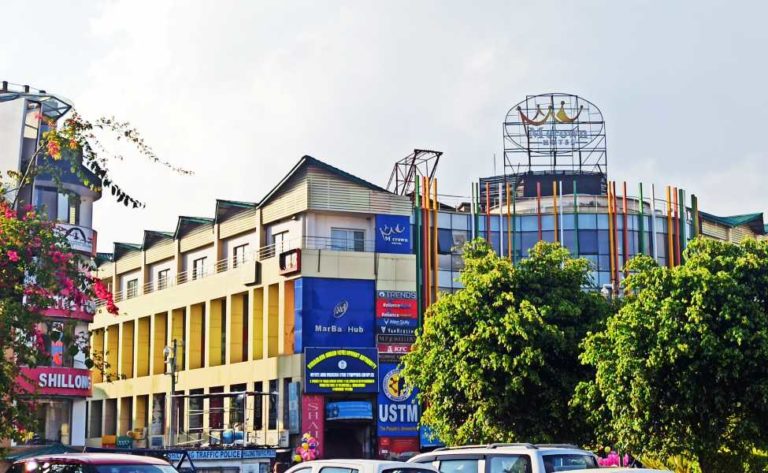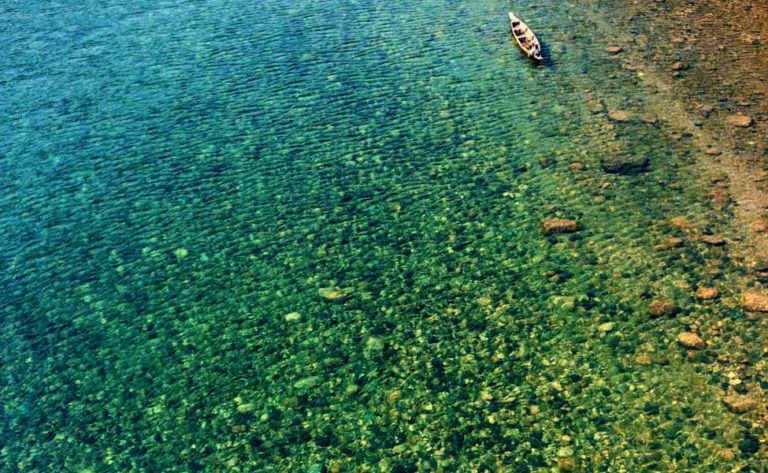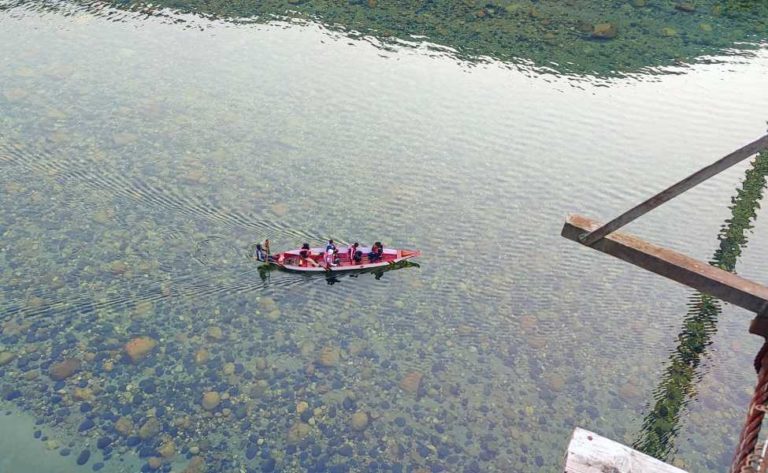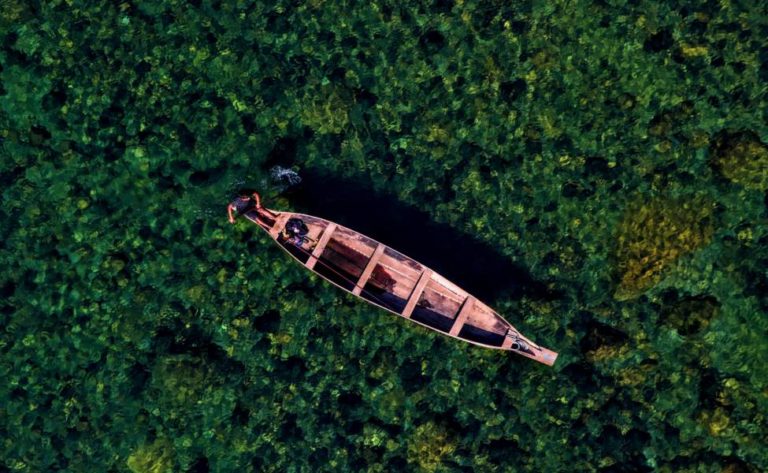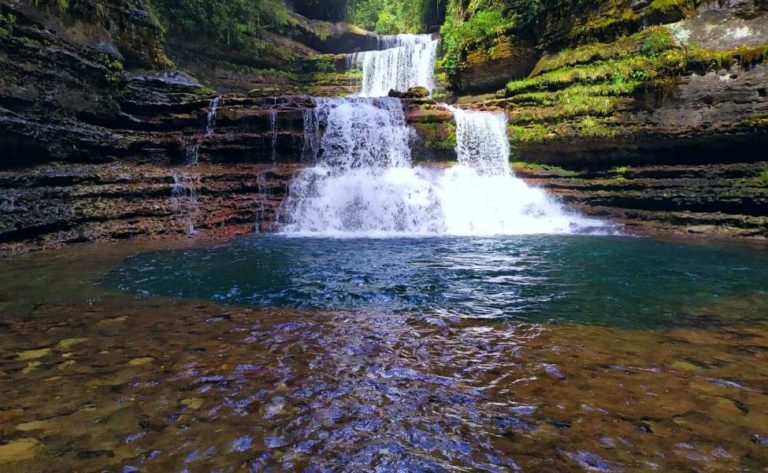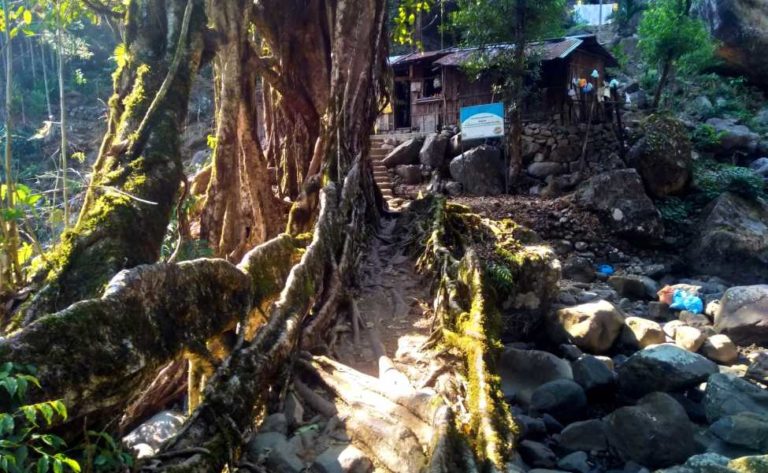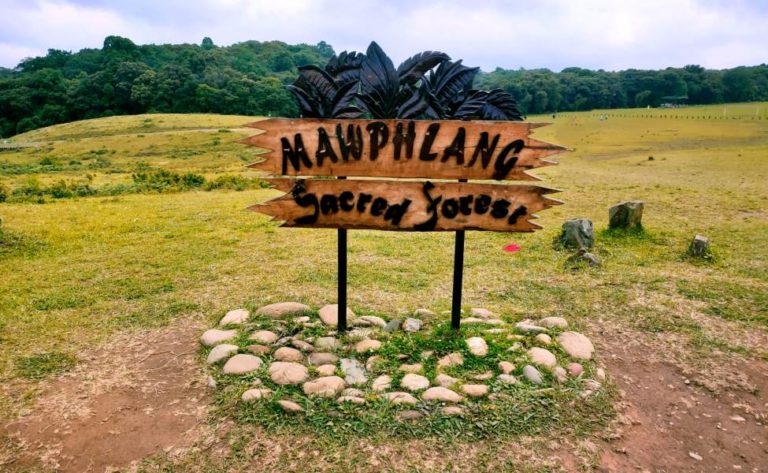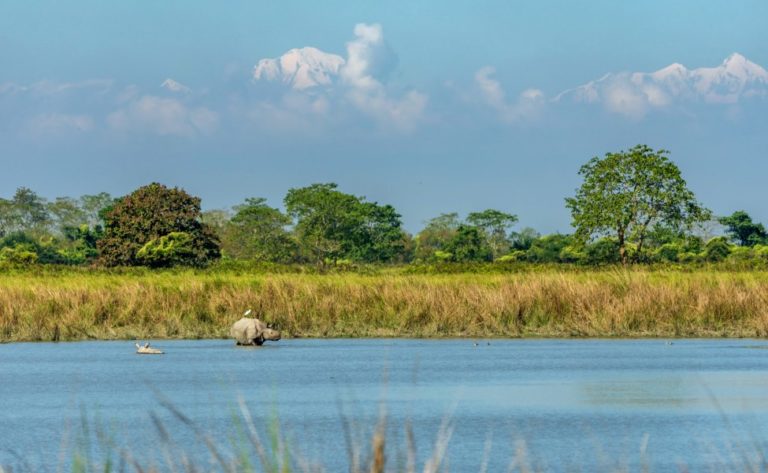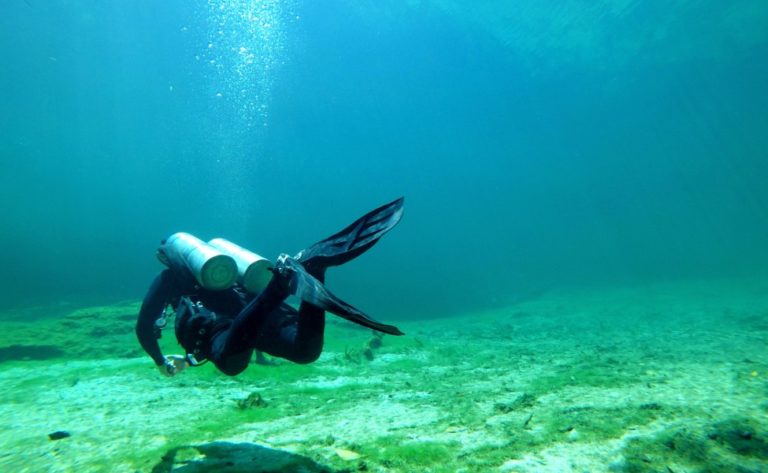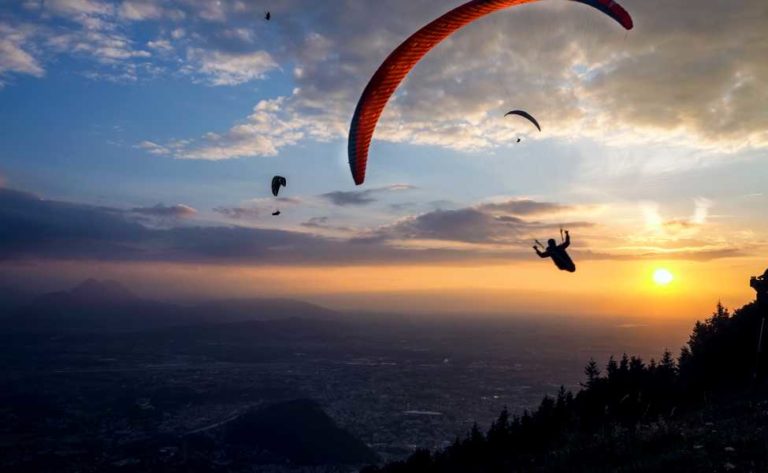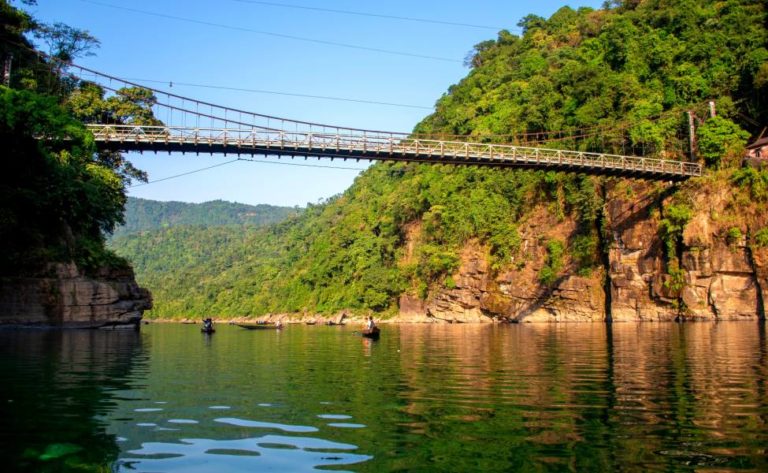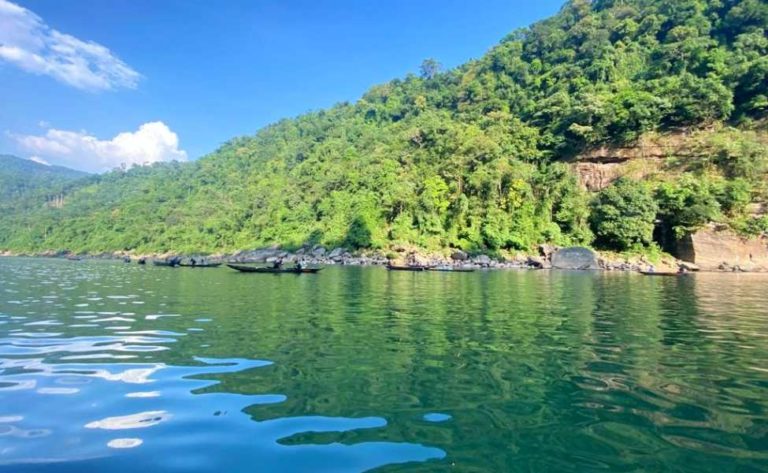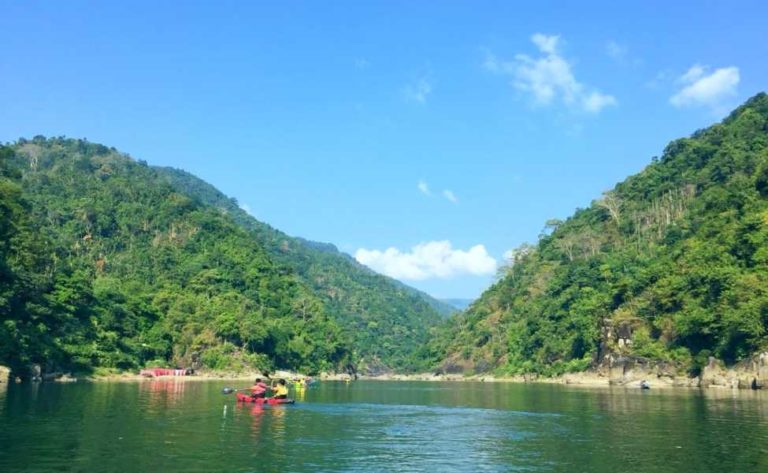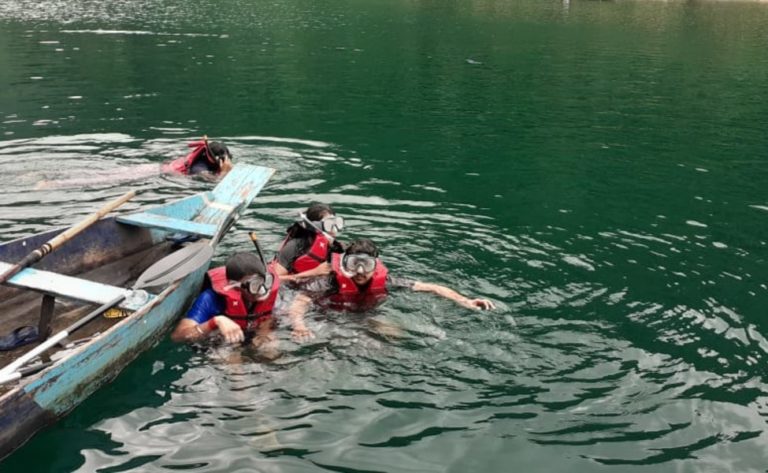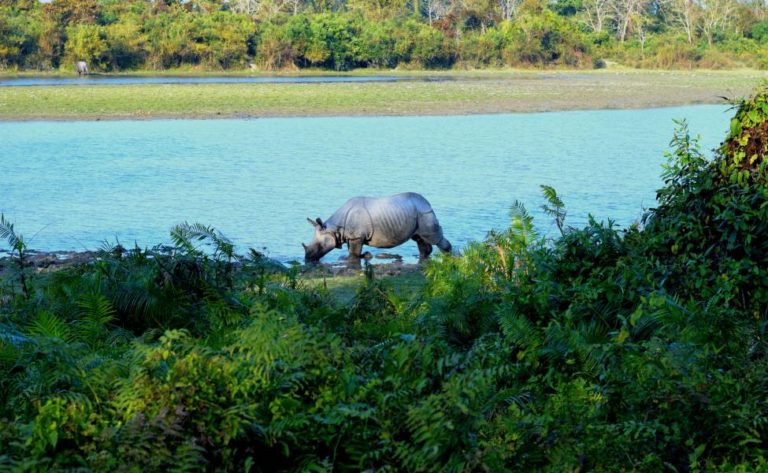
Places to visit in Assam
Places to visit in Assam
Assam is an Indian state located in the northeastern region, famous for its lush greenery, tea plantations and cultural richness. The state is home to the Brahmaputra River and the Kaziranga National Park, which is a UNESCO World Heritage Site and attracts many tourists. The capital city is Dispur and the largest city is Guwahati. Assamese is the official language and the state boasts of a diverse population of Assamese, Bodo and various tribal groups.
Travel Guides
Places to visit in Assam
Kaziranga National Park
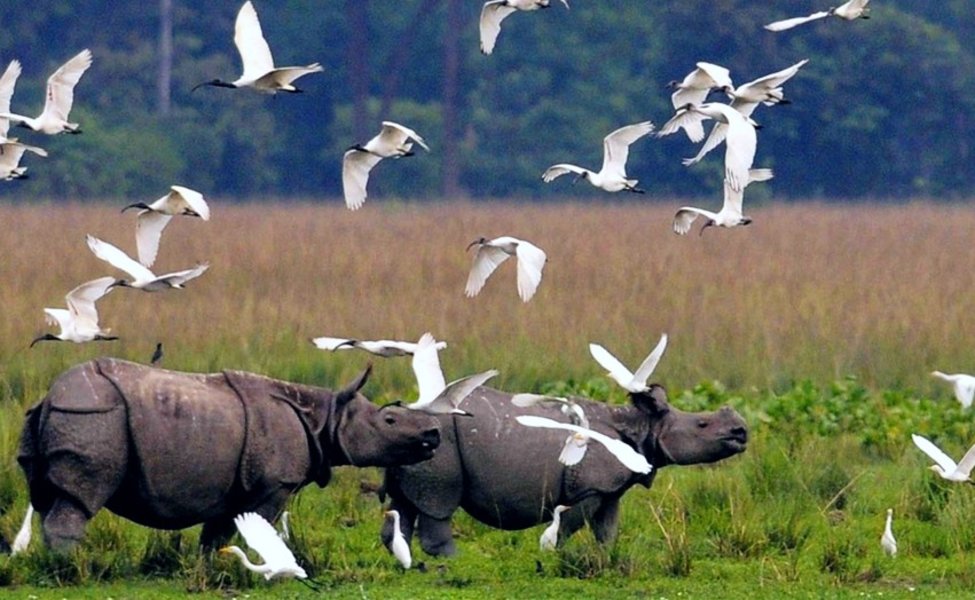
Kaziranga National Park, situated in the Indian state of Assam, is a UNESCO World Heritage Site renowned for its vast population of Indian one-horned rhinoceroses, as well as other critically endangered species like tigers, elephants, and swamp deer. Spreading across an area of 430 square kilometers on the edge of the Brahmaputra floodplain, the park boasts of tall elephant grass, marshlands, and lush tropical moist broadleaf forests, providing an ideal habitat for a diverse array of wildlife. Kaziranga is also a renowned bird-watching destination, with over 450 species of birds recorded in the park. The park is famous for its annual elephant and rhinoceros census, conducted to keep track of their population.
Kaziranga is a popular tourist destination, attracting numerous visitors who come to witness the wildlife and soak in the natural beauty of the park. It is open to visitors from November to April, with the best time to visit being the dry season when the grass is shorter and the animals are more visible.
Manas National Park
The National Park located in the state of Assam in India is a remarkable natural area that boasts several prestigious titles, including being a UNESCO Natural World Heritage Site, a Biosphere Reserve, and a Project Tiger Reserve. Spanning over 950 square kilometers and situated in the Himalayan foothills, the park is renowned for its diverse array of wildlife, including tigers, elephants, rhinos, gaurs, water buffaloes, and a wide range of bird species.
In addition to its rich wildlife, the park also serves as home to several indigenous communities, such as the Bodo people, who have lived in the region for generations. Despite being closed during the monsoon season, from May to October, the best time to visit the park is during the dry and cool winter months. Visitors can take in the park’s beauty through a variety of means, including elephant or jeep safaris, boat trips along the Manas river, or by embarking on one of the park’s many trekking trails.
Manas river
The Manas River, running through the park, serves as its lifeline and is also a natural dividing line between India and Bhutan. Its location in the transition zone between the Himalayan and Indo-Malayan biogeographic regions makes it a rare and exceptional hub of biodiversity. Moreover, it is one of the scarce protected areas in India where the wild water buffalo population thrives, adding to its already rich and diverse wildlife.
Additionally, the Manas National Park is home to several endangered species such as the one-horned rhino, clouded leopard, and the Royal Bengal Tiger. It is also a crucial habitat for many bird species, making it a popular destination for birdwatchers. The park not only serves as an important wildlife refuge but also holds cultural significance for the indigenous communities residing in the area. Its rich natural heritage has earned it a place as a UNESCO World Heritage Site, making it a valuable asset for both India and Bhutan.
Majuli Island
Majuli, located in the Brahmaputra River in the Indian state of Assam, is the world’s largest river island. It is known for its distinct culture, traditional handicrafts, and scenic landscapes. The island serves as an important center for the practice of neo-Vaishnavism, a form of Hinduism that originated in the region in the 16th century.
Majuli is home to several ancient satras or monasteries, which play a crucial role in preserving Assamese culture and heritage. These satras are known for their traditional performances of dance, music, and theater, unique to the island. The island is also recognized for its traditional mask-making, pottery, and bamboo crafts.
The island boasts a rich variety of flora and fauna and is a popular wintering ground for migratory birds, making it a prime location for birdwatching. Majuli is also renowned for its traditional fishing methods exclusive to the region.
Unfortunately, the island is suffering from severe erosion caused by the Brahmaputra River and has lost a considerable portion of its landmass over the years. The government of Assam has taken various measures to protect the island and its inhabitants. Visitors can reach the island by taking a ferry from Neamatighat in Jorhat district or by road and ferry.
Sivasagar
Sivasagar, also known as Sibsagar, is a city located in the Indian state of Assam renowned for its rich cultural heritage and historical significance. It served as the capital of the Ahom kingdom, which ruled over Assam for almost 600 years, and is named after the Sivasagar tank, a vast water body constructed by King Siva Singha in 1734.
The city boasts of its renowned attraction, the Sivasagar Sivadol temple complex, which is a cluster of three temples dedicated to Lord Shiva and built by the Ahom kings in the 18th century. These temples are noted for their unique architectural style, adorned with intricate carvings and sculptures, and are considered to be some of the best examples of Ahom architecture.
In addition to the temple complex, Sivasagar is home to other historical monuments such as the two-storied Rang Ghar amphitheater built by King Pramatta Singha in 1746, and the Talatal Ghar palace constructed by King Rajeswar Singha in the 18th century.
The city is also well-known for its tea gardens, making it a popular destination for tea tourism. Visitors can learn about the history of tea cultivation in the region, and take a tour of a tea factory to observe the tea-making process.
Sivasagar is conveniently accessible by road, rail, and air, connecting it to other parts of Assam, and can be reached by bus, train, or flight.
Guwahati

Guwahati, located on the south bank of the Brahmaputra River, is the largest city in the Indian state of Assam and a major commercial hub in northeastern India. It acts as a gateway to the region and is known for its fast growth. The city holds a rich cultural heritage and historical significance, with several important temples and shrines located in the area.
One of the most famous attractions in Guwahati is the Kamakhya Temple, a revered Shakti shrine dedicated to the Hindu mother goddess Kamakhya. The temple is renowned for its annual Ambubachi Mela, a four-day festival celebrating the goddess’s menstruation. Other notable places of worship in the city include the Basistha Temple, the Navagraha Temple, and the Umananda Temple.
Guwahati also houses the State Museum, showcasing a vast collection of artifacts and artworks from the northeastern region and Assam. The city boasts a diverse population and is famous for its flavorful street food, which is a fusion of various regional cuisines.
With well-developed infrastructure and easy accessibility via road, rail, and air, Guwahati is a convenient destination for visitors. It is well-connected to other parts of India and to other regions in North East India, making it a popular destination for travelers.
Pobitora Wildlife Sanctuary
Pobitora Wildlife Sanctuary, located approximately 50 km east of Guwahati in the Indian state of Assam, is a protected area renowned for its high density of Indian rhinoceros. Spanning 38.8 square kilometers, the sanctuary is home to a diverse array of wildlife, including Indian elephants, wild water buffaloes, Indian gaurs, and spotted deer, as well as over 200 species of birds.
In addition to its abundant wildlife, Pobitora Wildlife Sanctuary also provides an opportunity to learn about the local culture and lifestyle through interaction with the local communities. Visitors can go on a unique elephant safari to explore the park, and the best time to visit is from November to April.
The sanctuary is easily accessible by road, with the nearest town being Morigaon which has good road connections to Guwahati and other parts of the state. With its rich biodiversity and cultural offerings, Pobitora Wildlife Sanctuary is a must-visit destination for nature and cultural enthusiasts alike.
Additionally, the sanctuary is also an important ecotourism destination and supports conservation efforts for the Indian rhinoceros and other endangered species. Visitors can contribute to these efforts by following park regulations and respecting the wildlife and their habitats. The sanctuary staff provides educational and awareness programs to visitors, highlighting the importance of conservation and sustainable tourism.
For those interested in wildlife and nature, a visit to Pobitora Wildlife Sanctuary offers a unique and unforgettable experience. From the opportunity to see the majestic Indian rhinoceros in the wild to exploring the local culture, the sanctuary provides a well-rounded and educational experience for visitors of all ages. So, if you’re looking for a scenic and enriching adventure, a trip to Pobitora Wildlife Sanctuary is definitely worth considering.
Dibru-Saikhowa National Park
The Dibru-Saikhowa National Park is a renowned conservation area located in the Indian state of Assam, just 12 km from Tinsukia. With a total area of 765 square km, the park boasts a diverse biosphere that comprises of semi-evergreen forests, grasslands, and wetlands.
The park is a haven for wildlife, with a special focus on the preservation of the wild horse species, known as the Dibru horse. Additionally, it is a birdwatcher’s paradise with over 300 species of birds identified in the park, including the highly rare white-winged wood duck.
Not only does the park host a rich natural heritage, but it also holds significant cultural significance with various ethnic communities residing in its vicinity. Visitors can interact with the local people, learn about their customs and traditions, and gain insight into their way of life. The park also offers a unique experience by providing boat rides on the Brahmaputra River, which offers a different perspective of the park.
The Dibru-Saikhowa National Park is open throughout the year, but the ideal time to visit is from November to April. The park can be reached by road, boat, or train, with convenient connections to major cities in the state.
Hoollongapar Gibbon Sanctuary
Hoollongapar Gibbon Sanctuary, also known as Hoollongapar Reserve Forest, is a protected area situated in the Indian state of Assam, 20 km from Jorhat. The sanctuary spans 21.05 square km and is renowned for its unique biodiversity and the conservation of the Hoolock Gibbon, which is the only type of ape found in India and is considered one of the most endangered primates in the world.
The sanctuary serves as a home to various species of wildlife, including elephants, tigers, leopards, and different species of deer and primates. It is also a birdwatcher’s delight with over 200 species of birds recorded in the area.
The Hoollongapar Gibbon Sanctuary is a popular destination for nature enthusiasts and researchers, as it provides an ideal setting to observe and study the Hoolock Gibbons. Visitors can take a leisurely walk through the sanctuary, take in the scenic views of the forests, hills, and rivers, and participate in nature walks, bird watching, and jungle safaris.
The sanctuary is open all year, but the best time to visit is from November to April. It can be easily reached by road, as it is well connected with major cities in the state.
Nameri National Park
Nameri National Park is a protected area situated in the Indian state of Assam, about 35 km from Tezpur. The park covers an area of 200 sq km and is recognized for its unique biodiversity and the conservation of the white-winged wood duck, one of the rarest ducks in the world.
The park is a habitat for a diverse range of flora and fauna, including elephants, tigers, leopards, and various species of deer and primates. It is also a haven for bird enthusiasts, with over 300 species of birds recorded in the area, including the endangered white-winged wood duck.
Nameri National Park is a popular destination for nature lovers and researchers, as it offers an ideal environment for observing and studying the behavior of various species of animals and birds. Visitors can explore the park on foot and take in the breathtaking views of the forests, hills, and rivers. They can also participate in nature walks, bird watching, and jungle safaris.
The park is open all year, but the best time to visit is from November to April. It can be easily accessed by road, as it is well connected with major cities in the state. The park can also be reached by air through Tezpur airport and by train through Rangapara North Railway Station.
Tezpur:
Tezpur is a bustling city situated in the Indian state of Assam, renowned for its picturesque beauty and rich cultural heritage. The city lies along the banks of the mighty Brahmaputra River and has earned the title of “Cultural Capital of Assam.” Tezpur serves as a hub for education, industry, and commerce, offering a wealth of opportunities for its residents.
The city boasts a rich historical and archaeological background, featuring many ancient temples, monuments, and ruins that embody the rich cultural heritage of Assam. The most notable of these is the Basudeb Temple, believed to have been constructed in the 9th century. Additionally, Tezpur is a significant center of education and research, with several esteemed colleges and universities, including the highly regarded Tezpur University.
Tourism also flourishes in Tezpur, with several popular destinations such as Nameri National Park, Dhekiakhowa Bornamghar, and Cole Park. The surrounding hills, tea gardens, and the Brahmaputra river offer breathtaking opportunities for trekking, river rafting, and bird watching.
Tezpur is well-connected to major cities in Assam, as well as other cities in India, through air, rail, and road transport. The Tezpur airport is located nearby, and the city is easily accessible by train from major cities.
Jorhat
Jorhat is a city located in the Indian state of Assam and is the second-largest city in the state. It is renowned for its rich cultural heritage, tea production, and abundant historical and cultural monuments. Jorhat is considered the “tea capital of the world” due to its abundance of tea gardens.
The city boasts several historical and cultural landmarks, including the Jorhat Gymkhana Club, which is one of India’s oldest and most prestigious clubs, and the 18th-century Rajbari palace built by the Ahom kings. Additionally, Jorhat is home to a number of museums that showcase the region’s rich cultural heritage, such as the Jorhat Science Centre and Planetarium and the Jorhat Museum.
Jorhat is also a major hub for education and research, with several colleges and universities, including the Assam Agricultural University and the Central Institute of Technology. The city is a popular tourist destination, featuring popular attractions such as the world’s largest river island, Majuli Island, and the Hoollongapar Gibbon Sanctuary, known for its unique biodiversity and conservation efforts for the Hoolock Gibbon. The nearby tea gardens and Brahmaputra river offer thrilling opportunities for trekking, river rafting, and bird watching.
Jorhat is well connected to major cities in Assam and throughout India, via air, rail, and road transport. The Jorhat airport is the nearest airport, and the city is also easily accessible by train from major cities in India.
Nagaon
Nagaon is a city located in the Indian state of Assam, serving as the administrative center of Nagaon district. The city is renowned for its rich cultural heritage, historical landmarks, and proximity to various national parks and wildlife sanctuaries.
Nagaon boasts a rich history, visible in its ancient temples and monuments, including the Kamakhya Temple, one of the most revered Hindu shrines, and the Hulukanda Temple, a unique hilltop temple. It is also home to the Kirtanghar, a sacred place for Vaishnavism followers.
In addition to its cultural richness, Nagaon is a hub of education and research, with several colleges and universities, including the Nagaon Engineering College.
Nagaon is also a popular tourist destination, with attractions such as the Pobitora Wildlife Sanctuary, known for its significant Indian rhinoceros population, and the Dibru-Saikhowa National Park, a biodiversity hotspot and prime bird-watching area. The city also stands out for its tea production and tea culture, as seen in its surrounding tea gardens.
Nagaon is well connected by road and rail to major cities of the state and country, with the nearest airport being the Guwahati airport.
Sualkuchi
Sualkuchi is a picturesque town situated in the state of Assam, India, nestled along the banks of the mighty Brahmaputra river. It boasts a rich cultural heritage and is renowned for its handloom weaving industry, which produces some of the finest quality silk in the world. The town is known for its unique Muga silk, which is highly prized for its strength and durability.
Sualkuchi is home to numerous weavers who use handlooms to create a wide range of silk products including sarees, mekhela chadors, and gamosas. The town also showcases its traditional Assamese culture through its numerous temples and cultural centers, with the most notable being the Kachari Temple and the Sualkuchi Satra.
Tourists from far and wide flock to Sualkuchi to witness the traditional handloom weaving process and purchase silk products directly from the weavers. One of the popular tourist destinations is the Sualkuchi Handloom Weaving Center, which offers a glimpse into the town’s handloom weaving industry.
Sualkuchi is well-connected to major cities of the state and the country through road and rail links, and the nearest airport is the Guwahati airport.
Tawang Monastery
Tawang Monastery, also known as Tawang Gompa, is a landmark Buddhist institution located in the Indian state of Arunachal Pradesh. With a history dating back to the 17th century, it is considered to be the largest monastery in India and the second largest in the world after the Potala Palace in Lhasa, Tibet.
Nestled in the stunning Tawang Valley, the monastery sits at an elevation of 10,000 feet and is surrounded by magnificent snow-capped peaks and lush green forests. The main prayer hall of the monastery is home to a massive statue of Lord Buddha, considered to be one of the largest in the world.
The Tawang Monastery is not only a place of worship but also serves as a hub for the study of Buddhist philosophy and religion, housing over 500 monks. It holds a wealth of historical artifacts, including painted scrolls (thangkas), ancient texts, and religious objects.
Visitors to the Tawang Monastery can marvel at its beautiful architecture, tranquil surroundings, and rich cultural heritage. The annual Tawang Monastery Festival, held in November, is a popular event that showcases the cultural richness of the Monpa people through traditional dances, music, and food.
The Tawang Monastery is easily accessible by road, with a journey from Guwahati taking approximately 5-6 hours. The nearest airport is located in Tezpur, Assam, about a 5-hour drive from Tawang.
Digboi
Digboi is a town located in the Indian state of Assam and is recognized as the first oil-refining town in Asia. It is situated in the Upper Assam region and is renowned for its vast natural resources, particularly oil and natural gas. In 1889, the first oil well in Asia was discovered here by the Assam Oil Company, a subsidiary of the Burmah Oil Company, which later became the Burmah Oil Company. Since then, Digboi has developed into a crucial oil-producing center in India and is home to multiple refineries, including the Digboi Refinery which is one of India’s earliest and most sophisticated refineries.
Aside from its oil industry, Digboi has a rich cultural background and history. It boasts several historic sites, such as the Digboi War Cemetery, a final resting place for soldiers who died in World War II. The Digboi Centenary Museum, which displays the history of the oil industry in the region, is also a popular tourist spot. The town is home to several wildlife sanctuaries, such as the Dehing-Patkai Wildlife Sanctuary, which boasts a variety of flora and fauna including endangered species.
Digboi is easily accessible by road and rail, connecting to major cities in the state and country. The nearest airport is the Mohanbari Airport in Dibrugarh, located 80km away.
Bishwanath Temple
It is a Hindu temple situated in the Indian state of Assam, in the city of Guwahati. It is individual of ultimate old and protected synagogues in united states of america, loyal to Lord Shiva. The shrine is as known or named at another time or place Bishnupad Temple, and is deliberate expected individual of ultimate main shrines of the Shaiva religion in the domain.The place of worship is trusted to have happened buxom apiece king of the Pala Dynasty, Dharmapala, in the 8th centennial AD.
The church is make sense of rock formed from sediment and has a singular structural style, accompanying a cut-formed tower and complicated carving and sculptures on the divider. The chapel again has a big court and a container, that is deliberate expected protected.The mosque is famous for allure annual Bishnupur Mela, that is grasped in the period of January and is accompanied by millennia of fans from everywhere the domain. The sanctuary again offers miscellaneous traditions and puja aids, containing the Abhishekam and the Rudrabhishekam.The Bishwanath Temple is situated in the middle Guwahati city and is surely approachable by avenue. It is about 20km from the airstrip and the most familiar railroad station is Guwahati railroad station that is about 7km from the church. The house is between various added places of interest like the Kamakhya Temple, Umananda Temple, and the Assam State Museum that maybe bothered also.
Madhapur Lake
It is a artificial lake situated in the Indian state of Assam, in the district of Lakhimpur. The pond is situated in the Madhapur center of North Lakhimpur and is known for its beautiful beauty and friendly atmosphere. The pool is a popular spot for angling and boating, and is still a popular spot for picnics and character walks.The lake was assembled in the year 1915, for one British government for irrigation and flood control. The lagoon is fed apiece River Subansiri and its tributary.
The lake has a maximum insight of about 10 feet. The pond is surrounded by a thick forest and is a perfect place for fowl watching.The lake is too home to a variety of bait species, containing the popular Indian bigger carp and catfish, that are commonly taken by local fishermen. The lake is likewise an important breeding ground for various species of waterbirds, containing the spot-billed pelican, the excellent cormorant, and the darter.The Madhapur pool is located about 50km from the commune headquarters of North Lakhimpur.
The most forthcoming railway station is at North Lakhimpur that is about 40km away and the most forthcoming airport is at Mohanbari in Dibrugarh which is about 150km continuously.The lake is a perfect place to give a relaxing era, enjoying the everyday beauty of the encircling area. Visitors can again take a boat ride on the pond, and enjoy the beautiful surroundings and the peaceful air.
Frequently Asked Questions on Assam
Some common places to visit in Assam contain the Kamakhya Temple, that is individual of the most aged of the 51 Shakti Peethas, a Hindu house complex loyal to the god of capacity and productivity. Kaziranga National Park, a UNESCO World Heritage Site and a common goal for being devotees, famous for allure individual-sharp rhinoceroses. Majuli Island, the best river isle in the realm and a center of Assamese civilization and usual practices. Sivasagar, an old city famous for allure factual sites to a degree the Sivasagar Sivadol and the Rang Ghar.
The months of October to April are ideal for visiting Assam since the weather is nice and ideal for sightseeing. The temperature remains moderate and comfortable throughout this season, making it a great time to enjoy the state’s natural beauties.
The Kamakhya Temple, dedicated to the goddess of force and fertility, is a well-known Assamese temple. It is one of the 51 Shakti Peethas and attracts thousands of pilgrims every year. The temple is located atop Guwahati’s Nilachal Hill and is said to have been erected in the 17th century.
Kaziranga National Park, noted for its one-horned rhinoceroses, and Manas National Park, a UNESCO World Heritage Site, are two of Assam’s most notable wildlife sanctuaries. These sanctuaries allow visitors to experience the state’s diverse wildlife. These parks also house the magnificent elephant, tiger, water buffalo, and several other animal and bird species.
Taking a trip on the Brahmaputra River, the state’s lifeline and the biggest river in India, seeing tea estates, and experiencing the traditional culture of Mishing village are just a few of the unique activities available in Assam. Visitors may learn about the Mishing people’s rituals, traditions, and way of life, which are noted for their rich culture and tradition.
Assam may be reached by bus, rail, or vehicle. There are various state-run and private buses that link the state’s major cities and communities. The railway is another common form of transportation, with multiple lines connecting Assam to the rest of the country. You can take a cab or rent a car if you want to go by automobile.
Yes, traditional handicrafts like as bamboo and cane items, silk products, and bell metal and brassware can be found in Assam. These products represent the state’s rich culture and heritage and make excellent mementos and presents.
You can organise your trip to Assam by studying the many sites to visit, creating an itinerary, and pre-booking your transportation and accommodations. Checking the weather prediction and packing properly is also a smart idea. You may also seek the assistance of a local tour operator, who can prepare a full itinerary and make all essential preparations for your trip.
The use of fresh herbs and local ingredients distinguishes Assamese cuisine. Popular delicacies include fish curry, dhekia xaak aru bhaji (fiddlehead fern bhaji), and bamboo shoots. Assamese cuisine is also notable for its use of minimum spices and a variety of lentils and vegetables. Assam is also well-known for its tea, which comes in a variety of tastes.
Yes, visiting Assam on a budget is feasible. There are several inexpensive lodging alternatives, including as guesthouses and homestays, and you may also save money by using local transportation and eating street cuisine. You may also organise your trip to include free activities like visiting temples and historical sites and going for nature walks.

